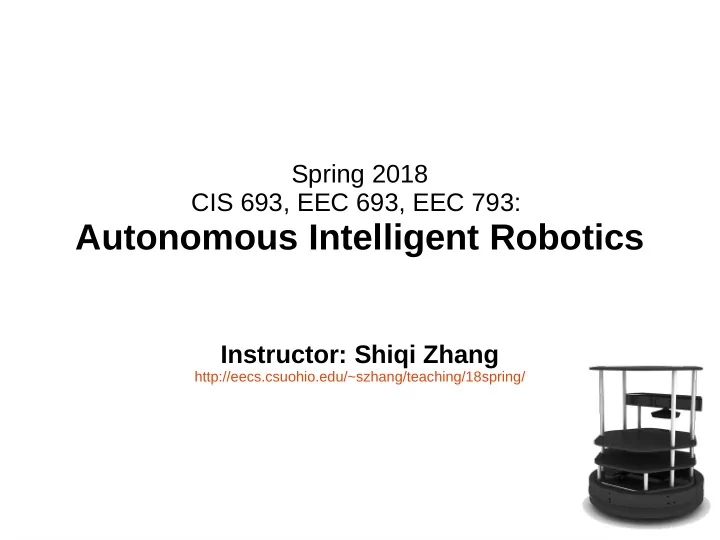

Spring 2018 CIS 693, EEC 693, EEC 793: Autonomous Intelligent Robotics Instructor: Shiqi Zhang http://eecs.csuohio.edu/~szhang/teaching/18spring/
Reading: “BWIBots: A platform for bridging the gap between AI and Human-Robot Interaction research” ● Planning using action language BC – Will be discussed in “task planning” ● Incorporating uncertainty into planning – Will be discussed in “commonsense reasoning” ● Understanding natural language requests – Will be discussed in “natural language processing”
What type of robot do you need? https://www.ted.com/talks/a_robot_that_flies_like_a_bird At 2:00
Indoor wheeled robots 3k-6k
Indoor wheeled robots 3k-6k 30k-60k
Indoor wheeled robots 3k-6k 30k-60k 300k-600k
Indoor wheeled robots 3k-6k 30k-60k 300k-600k How are they different?
BWIBot hardware
What exactly is happening? Video
Symbolic-level planning: goto(room_101) Semantic map 2d position: <x, y, theta> Global path planner 2d trajectory Local path planner Control signals
Planning at symbolic level ● A description about action preconditions and effects ● Initial and goal states
Global path planning ● A PRM example
Local path planning for obstacle avoidance
Questions ● Which level robot localization is placed at? – Particle filter (AMCL) – Kalman filter ● Where is obstacle avoidance? – Dynamic window – Vector Field Histogram ● Where is A* and/or Dijkstra?
The software architecture for the BWIBots
The next reading Fox, Dieter, Wolfram Burgard, Frank Dellaert, and Sebastian Thrun. ● "Monte carlo localization: Efficient position estimation for mobile robots." AAAI/IAAI 1999, no. 343-349 (1999): 2-2. This paper just won the AAAI Classic Paper Award ● https://rse-lab.cs.washington.edu/2017-aaai-classic-paper-award-goes-to-monte-carlo-localization-paper/
Recommend
More recommend